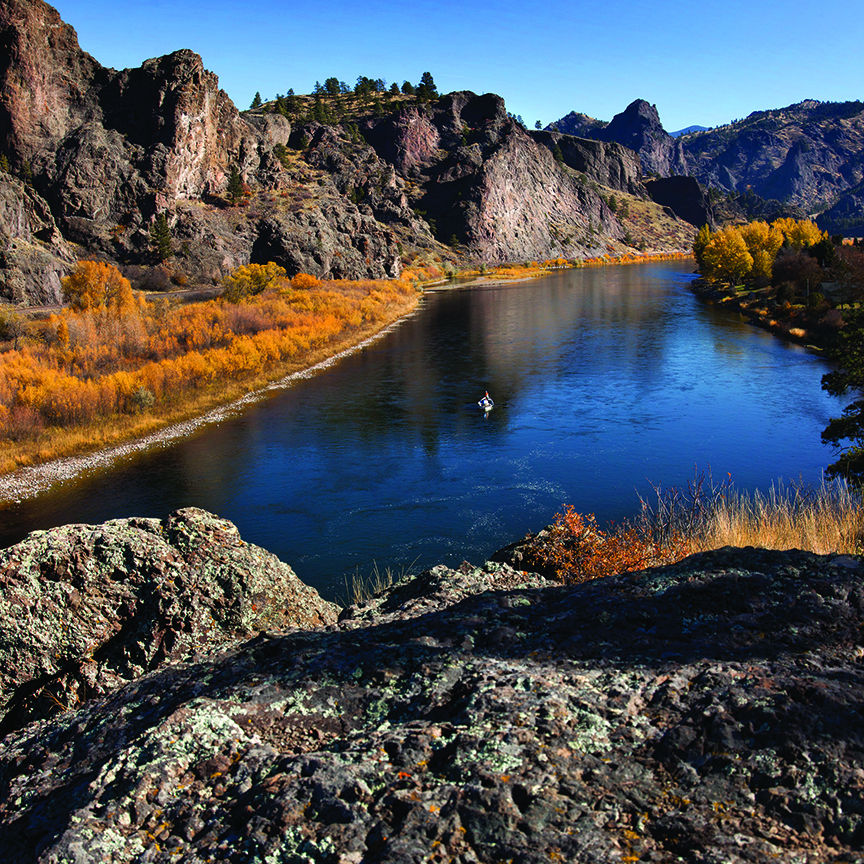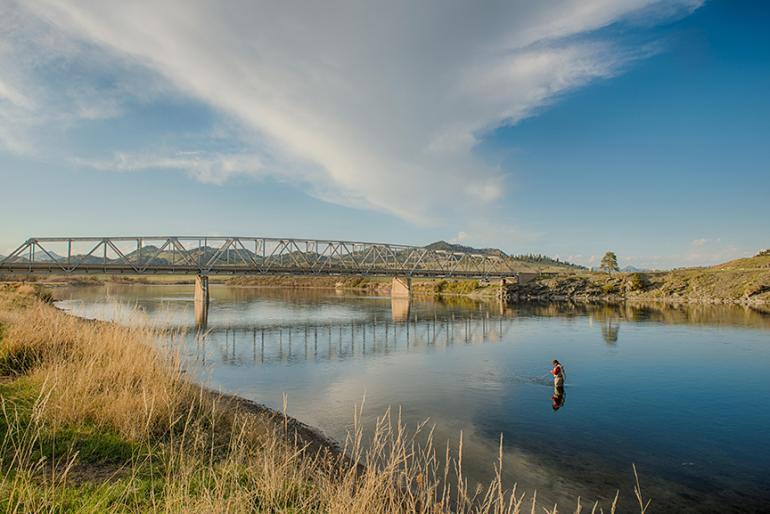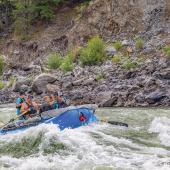The Missouri River
Small flies, big action.
Three fabled rivers—the Madison, the Gallatin, and the Jefferson—all flow into each other at Missouri Headwaters State Park to form the mighty Missouri River. From here, the river travels through four dams on its way north by northeast past Helena, then on to Great Falls and beyond. The towns of Craig and Wolf Creek are just over two hours northwest of Bozeman and serve as the main jumping-off points for anglers fishing the Missouri. Both towns sport their share of fly shops, restaurants, lodging, and of course, a plethora of bars.
Access
The Missouri below Holter is probably the most accessible trout stream in Montana. The Missouri River Recreation Road parallels the river from the dam all the way to the town of Cascade for about 24 miles. In some stretches, you can enjoy road access from both sides of the river. Between the dam and Cascade, there are 13 state access sites, one federal access site, 11 boat ramps, ten public RV and tent-camping areas, and five private RV parks. On top of all that, there are a few dozen walk-in access areas, mostly by cooperative landowners.
Flows
Being a tailwater, the Missouri has pretty steady flows all year long. Runoff does have a small impact on the river, but mostly from the standpoint of wade angling. Drift boats and rafts will still enjoy good fishing even at some pretty stout flows. The usual time for these higher flows is in June, which is a little later than most of the freestone rivers in the area. Runoff from the freestone rivers and streams flows into Canyon Ferry, the main holding reservoir in the system. Canyon Ferry is lowered in the fall and winter in preparation for this spring runoff. Once the reservoir is nearly full, the flows out of the dams are then increased. Regardless of volume, the flows from Holter Dam are usually clear. A normal runoff year will see a two- or three-week period in late May to the middle of June, with flows ranging from 10,000 to 15,000 cfs. Typical flows for most of the rest of the year range from 4,000 to 6,000 cfs. The Missouri is wadeable at flows less than 7,500. Above that volume, it’s only safe to fish from a boat.

When to Go & What to Use
This river is a massive insect-producing factory. Most flies are small (#16-#20) on the Missouri, but what they lack in size, they make up for in quantity. The hatches on the Mo can be so thick you’ll swear you’re seeing a blizzard in July. Midges hatch all year long and even big fish like these tiny bugs. Best seasons for dry midge action is late autumn through spring.
Blue-winged olive (baetis) show up in spring and again in the fall. They like the crummy weather so if you don’t mind fishing in the rain or snow, you’ll love BWOs. The next-best mayfly hatch is the pale morning duns (PMD). They show up in June and go through July. The most prolific mayfly hatch, lasting from July through September, is the minute trico. With a big one being a #20, they are a challenge just to tie on your tippet, let alone hook and land a big trout. The Missouri also sees some March browns, brown drakes, and a few other mayfly species—but these don’t last long and are not as predominant as the big three: BWOs, PMDs and tricos.
The caddis hatch begins in May and goes through October. Most are tan/brown and will be around a size #14-#18. However, late September and October bring out the big #8 orange October caddis. Trout feed aggressively on the entire lifecycle of these bugs, so having a box with larva, pupa, emergers, adults, diving egg layers, and spent caddis will do you well most of the season on the Missouri.
Fish
When Lewis and Clark traveled this section, the only trout species in the river was the westslope cutthroat. These days, the most numerous fish in the Missouri is the rainbow trout. They outnumber the brown trout by about 8:1 in the upper river, and about 4:1 in the lower stretch. You will also catch the native but much-maligned mountain whitefish and an occasional carp. There are also walleye, suckers, and ling in the river, but it is rare to find one of those eating a fly.
Row vs. Wade
The Missouri’s broad, shallow streambed and smooth, easy current make it perfect for the angler both on foot and afloat. Many anglers like the challenge of patiently stalking the Missouri’s wary, wild trout in waders. Other folks like to cover more water to either look for rising fish or reach sections of river that just can’t be reached on foot. It is important to note that wade anglers have the right-of-way when a boat floats up to them, and rowers should try their best to give them plenty of room.

Regulations
The Missouri is open to angling year-round, and winter can be a great time for the locals to enjoy the popular trout stream without the tourists and guide traffic. The combined trout limit is three daily, only one over 18 inches, and only one brown trout in the Craig stretch. Numerous other specifics exist from the headwaters to Great Falls, so make sure to keep an up-to-date copy of the regs with you.
Getting There
From Bozeman, head west to Three Forks on I-90 and take Hwy. 287 north, which parallels the Missouri for about 100 miles. Hwy. 287 will turn into I-15 in Helena, which you can take all the way to Great Falls for even more great fishing.
Hotspots
The prime trout water consists of the tailwater downstream from Holter Dam. It boasts a staggering number of 8,000+ trout per mile, averaging 15-17 inches, with many fish reaching up to 20 inches in length. It’s easy to see why the Mighty Mo draws anglers from around the globe.
Chris Strainer works at CrossCurrents fly shop in Helena on the Missouri River in Craig.












